Tharp's Thoughts Weekly Newsletter
-
Article: Is There a Genius Trading State? Part II, by Van K. Tharp, Ph.D.
-
Workshops: The New Infinite Wealth Workshop is Coming in January
-
-
Tip: Low Interest Rates = More Borrowing… and More Corporate Debt, by D. R. Barton, Jr.
-

CLICK HERE to see what products are included in this sale!
Feature Article
Is There a Genius Trading State? Part II
by Van K. Tharp, Ph.D.
Click here to resolve formatting problems
In a previous article, I discussed several aspects of genius and described some of the traders that people tend to regard as geniuses: Sir John Templeton, John Paulson, and Ed Seykota. But were these people really geniuses or were they just at the right place at the right time? Understanding genius can help us answer that question.
In the article, I wrote about a core NLP principle — Alfred Korzybsky’s famous postulate that says “the map is not the territory.” In other words, we have no idea what reality truly is, we just have a map of reality instead. In his three book series Strategies of Genius, Robert Dilts said that geniuses are people with rich internal maps and such people tend to possess one or more of the following traits or abilities:
1) Strong visualization skills and perhaps photographic memories;
2) Numerous linkages between the various sense abilities;
3) Shifting easily between multiple perspectives and various perceptual positions;
4) Operating at a different logical levels while being able to chunk up to the big picture without difficulty and chunk down to extreme detail;
5) Maintenance of a feedback loop between the abstract and the concrete (specific sensory detail);
6) Emphasis on questions with an “I don’t know” attitude realizing that the answer is just a function of your internal map therefore likely to be a reality that you made up;
7) Usage of metaphors and analogies as ways of thinking;
8) Missions that go way beyond their individual identity.
There is, however, another approach to genius — genius mental states. Dr. Michael Hall is really the champion of this position having written four manuals with the topic genius in the title. Dr. Hall won a prize in the early 1990s for the most innovative NLP technique, something called metastates. Dr. Hall explained that people bring another mental state to a primary state and thereby create a metastate. Here’s a quick example — you are scared by something and then you get angry about being scared. In this case, fear is the primary state and anger is the metastate, the anger “textures” the primary state of fear.
Dr. Hall explains that genius is not a primary state itself but rather a metastate — which will be somewhat unique for each individual. Genius might be a rather unusual way of responding to a primary state — such as welcoming fear. It also occurs where someone textures one state with another, say a focused state textured with extreme pleasure. Imagine what that would be like.
In the last article, I asked readers what they thought a genius trading state would be and here are some of the responses:
-
Dan: The genius trading state is joy/pleasure, discovery.
- Christina: I think the primary states are focused attention and open mindedness. The textured states are confidence; enjoyment of following the rules; detachment from the results; and learning lessons.
- Stuart: I see myself wanting a calm, detached primary state wrapped in textures of determination to execute with a craftsman-like efficiency and intense focus on the process.
- Santosh: The primary state is curiosity textured around: loving the curiosity; being focused; being present in the moment; self-confidence; readiness to act; and seeing the perfection of the “what is” in the results.
- Ben had a combination of ten primary states textured with 8 secondary states.
- Dave identified three necessary metastates:
a. Identification of trades (creativity textured with joy and spiritual awareness)
b. Stalking and action (fear textured with focus and patience)
c. Managing and exiting trades (detachment with joy?)
- Ted suggested that the primary state would be a deep connection to the divine textured with the efficiency of a samurai warrior; gratefulness; courage and oneness.
- Linda said her primary state would be calmness textured with the ability to find value and seize opportunity.
- And lastly Steve suggested a primary state of looking for opportunity textured with balance.
Many of the primary states people listed are actually metastates already. Primary states are direct responses to the environment such as fear, anger, curiosity, focus, etc. Anything else is a metastate.
I suspect that some if the metastates listed might actually be genius states and the sets have various degrees of efficacy. I also imagine that each set of metastates listed is quite unique. Remember that in the last article I said genius states were probably unique to each individual?
Based on my promising research in this area so far, my plan now is to create and present a new workshop in late 2016 called Trading Genius. One main aspect of that workshop (perhaps a third of it) will be helping people get into a genius state. At the moment, however, I suspect that any particular optimal genius state relates to the objectives of the task at hand. So perhaps there’s not one genius state for everything that traders have to do but rather multiple genius states. Let’s take a look at several key areas for successful trading and see how genius states might help each one.
For example, some of the top tasks of trading such as Gratitude or Focus + Intention would have their own unique genius state directly implied by the name of the task. I believe that the overall purpose for all of the top tasks of trading is to follow your rules and make no mistakes. Thus, the genius state associated with the trading execution process would have as an objective - no mistakes.
Similarly, developing a system that fits you is another important aspect of trading and this task has three main objectives:
1) To generate low-risk ideas, that
2) meet your personal objectives, and
3) are designed to work well in one particular market type.
Thus, you would need a genius state that would help you meet those objectives and perhaps there’s a different genius state for each objective.
Thirdly, another aspect of successful trading requires that you treat it as a business, not a hobby. For this, you need to develop a trading business handbook like we request of our Super Trader candidates. The objectives for developing a business handbook are:
1) To thoroughly cover all aspects of the business of trading, and
2) to plan for worst-case contingencies.
Again, you would need two rather distinct trading genius states for the two different objectives in this task.
Finally and most importantly in my opinion, trading is all about knowing yourself, as you are the primary engine of your trading results. The genius state for this aspect of trading would allow you to know yourself, really explore your personal limitations and eliminate them.
As a result, I think there are actually between five and ten different trading genius states necessary to accomplish the tasks related to the overall mission of trading well. I also suspect that these states will still have somewhat unique qualities for each individual. For example, what genius state to you think you need to be able to trade mistake free, where a mistake means not following your written trading rules? That’s going to differ to some degree between you and any other trader.
I’ll keep researching in this area and let you know more about what I find.
About the Author: Trading coach and author Van K. Tharp, Ph.D. is widely recognized for his best-selling books and outstanding Peak Performance Home Study Program—a highly regarded classic that is suitable for all levels of traders and investors. You can learn more about Van Tharp at www.vantharp.com. His new book, Trading Beyond The Matrix, is available now at matrix.vantharp.com.
|
Workshops
Combo Discounts available for all back-to-back workshops!
See our workshop page for details.
Free Book We're Giving You a FREE Book!
TRADING BEYOND THE MATRIX
The Red Pill for Traders and Investors
We pay for the book, you pay for shipping.
ALL YOU HAVE TO DO IS CLICK HERE!
Below is a brief video on how powerful this book is to traders.

Trading Tip

Low Interest Rates = More Borrowing… and More Corporate Debt
by D. R. Barton, Jr.
Click here to resolve formatting problems
Goldman Sachs just published a report on corporate debt that has lit up Twitter and the blog-o-sphere. More importantly for traders and investors, the report contains cautionary advice that should be on your “what to watch for” list.
With interest rates having dropped since the Great Recession, it should be no surprise to anyone that companies have been borrowing more money. How much more? Lots more!
Let’s jump right in and look first at the chart from the Goldman report that’s getting the most play.
BusinessInsider.com presented this very nicely done version:
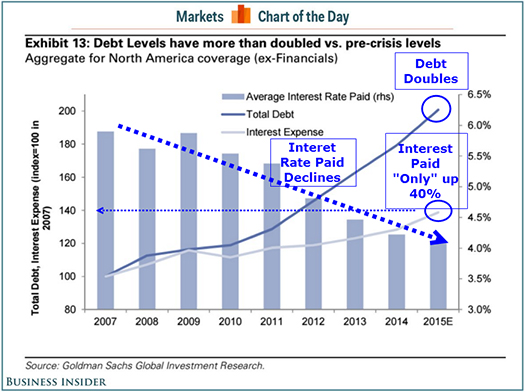
As the chart shows, corporate debt has doubled since 2007 (that’s a bunch) but the interest payments to service that debt have gone up only 40%. So is this increase in the corporate debt level really a big deal or is it just business as usual? As with most complex financial issues, the answer is not a firm yes or a firm no.
High Corporate Debt Levels, Not a Problem
So far, the stock market has loved what’s been happening to corporate balance sheets. Assets are being transferred from lenders to shareholders as a large chunk of the new corporate debt has been used for share buy-backs. As the number of shares decreases, the earnings per share (EPS) increases which benefits stock owners and helps support the indexes. Zerohedge.com calls the practice “corporate asset stripping to reward shareholders” and U.S. equity prices remain near the top of the chart.
So for the moment, the high debt level for corporations is not a problem ... until it is.
Not a Problem … Until It Is #1, Debt vs. Cash Flow
Goldman reports that corporate leverage is at the highest levels of the last decade — and that includes the 2007 top. More than the simple level of debt, however, the larger concern is that it’s growing much faster than earnings as this chart shows:
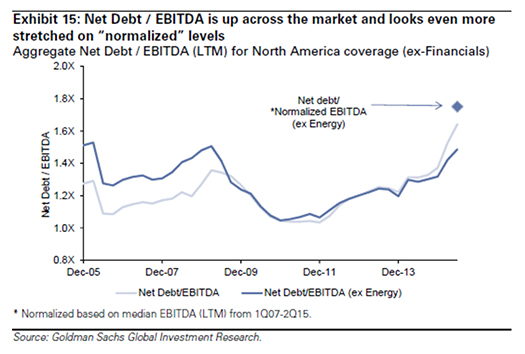
EBITDA (Earnings Before Interest, Taxes, Depreciation, and Amortization)
is a measure of cash flow. LTM means “last twelve months”.
Even without getting into the effects of normalization, the chart above makes clear that the level of debt growth is outstripping the corporations’ ability to repay it as measured by the growth in cash flow.
Not a Problem … Until It Is #2, So Much Goodwill
All of the M&A activity (which is reaching fevered levels right now) eventually shows up on balance sheets. The difference between what the acquired company is worth now and what acquirer hopes it will be worth (or paid for it!) shows up in the asset category of “goodwill”.
The Goldman Sachs report highlights the increasing level of goodwill as a percentage of total assets for corporations. Let’s look at a chart of this most ethereal phenomenon:
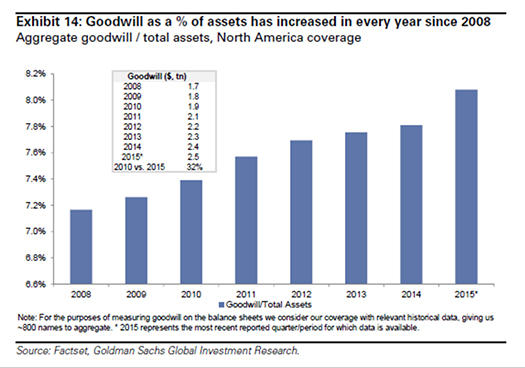
Goldman rightly points out that the collective increase in goodwill on balance sheets is another indication that companies are “failing to invest efficiently”. Really, that’s just a nice way of saying companies are paying too much to buy other companies. If the value implied by the goodwill on the balance sheet doesn’t show up, eventually companies have to take a write-down. Stay tuned…
Not a Problem … Until It Is #3, ROI?
So much of the growth in debt has gone into near-term fixes such as dividend hikes, mergers and acquisition (M&A), and share buy-backs. This balance sheet “financial engineering” does help the stock price and the EPS number but the bigger picture is being masked. The vast amount of borrowing has not been finding its way into productive new projects or capital investments. In time, those kinds of investments provide actual returns and the opportunity for true growth. Profitable projects and capital investments, however, are not where the debt has been going.
Beyond Tomorrow’s Business
The corporate practice of borrowing cheap money to buy back shares and finance over-priced M&A deals will continue for now. And, this debt accumulation will continue to bolster equity prices – until it simply can’t anymore.
Fed rate hike(s) are in the offing and companies that have absorbed a heaping helping of debt will have trouble refinancing short term debt at higher rates. Down the road, cash-strapped companies will do the exact opposite of what they are doing now. At that point, they will sell equity or divest parts of the company (with write-downs) to raise money. Before we start seeing that happen, however, attentive share owners will want to get out well ahead of those selling sprees.
This is not tomorrow’s business but it IS something every trader and investor should monitor carefully.
I always love hearing your thoughts and comments. Send them all to drbarton “@” vantharp.com.
Great Trading,
D. R.
About the Author: A passion for the systematic approach to the markets and lifelong love of teaching and learning have propelled D.R. Barton, Jr. to the top of the investment and trading arena. He is a regularly featured analyst on Fox Business’ Varney & Co. TV show (catch him most Thursdays between 12:30 and 12:45), on Bloomberg Radio Taking Stock and MarketWatch’s Money Life Show. He is also a frequent guest analyst on CNBC’s Closing Bell, WTOP News Radio in Washington, D.C., and has been a guest on China Central Television — America and Canada’s Business News Network. His articles have appeared on SmartMoney.com MarketWatch.com and Financial Advisor magazine. You may contact D.R. at "drbarton" at "vantharp.com".
Swing Trading Systems E-Learning Course
Now For A Limited Time 20% Off!
 The new Swing Trading Systems home study course is now available! Learn with Dr. Ken Long as he teaches his Swing Trading Systems Workshop via streaming video! The new Swing Trading Systems home study course is now available! Learn with Dr. Ken Long as he teaches his Swing Trading Systems Workshop via streaming video!
This new e-learning course includes Ken Long's Swing Trading Workshop, 5 swing trading systems and a bonus workshop featuring Van Tharp on Tharp Think principles. The course also includes extensive downloadable files to support your learning.
You can complete this course at your own pace, from the comfort of your own home or office, and access the materials as many times as you wish during your 1 year subscription period.
Take a look at this video from Ken to learn more about this course.
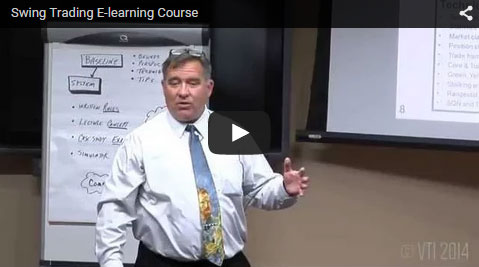
We have extensive information about the Swing Trading System e-learning course, including how to purchase...click the link below!
Learn More About The Swing E-Learning Course...
In the six minute video below, Ken analyzes several trades from the relatively quiet session on Monday, October 12. He opens with a swing trade that started last week on XIV talking about the entry, initial stop, target, and progress of the trade so far. That swing trade offers the opportunity trade XIV intraday with some confidence in the long bias. Ken provides two tradeable intraday scenarios for the XIV move during the Monday session and the position sizing ramifications for each. Ken then discusses a second trade where one of the traders in the chat room went short USO and earned a couple of R for the effort. 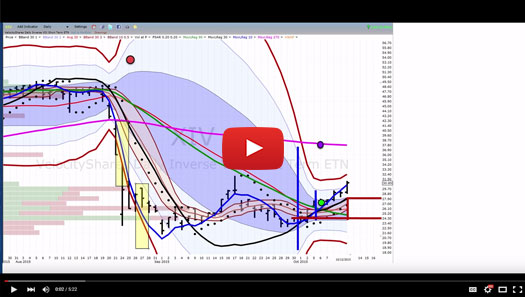
Matrix Contest
 Enter the Matrix Contest Enter the Matrix Contest
for a chance to win a free workshop!
We want to hear about the one most profound insight that you got from reading Van's new book, Trading Beyond the Matrix, and how it has impacted your life. If you would like to enter, send an email to [email protected].
If you haven't purchased Trading Beyond the Matrix yet, click here.
For more information about the contest, click here.
Ask Van...
Everything we do here at the Van Tharp Institute is focused on helping you improve as a trader and investor. Consequently, we love to get your feedback, both positive and negative!
Send comments or ask Van a question by clicking here.
Also, Click here to take our quick, 6-question survey.
Back to Top
Contact Us
Email us at [email protected]
The Van Tharp Institute does not support spamming in any way, shape or form. This is a subscription based newsletter.
To change your e-mail Address, e-mail us at [email protected].
To stop your subscription, click on the "unsubscribe" link at the bottom left—hand corner of this email.
How are we doing? Give us your feedback! Click here to take our quick survey.
Call us at: 800-385-4486 * 919-466-0043 * Fax 919-466-0408
SQN® and the System Quality Number® are registered trademarks of the Van Tharp Institute and the International Institute of Trading Mastery, Inc.
Be sure to check us out on Facebook and Twitter!
 
Back to Top |
|
November 11, 2015 #759
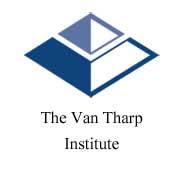
Our Mission
Van's Top-Twelve Favorite Trading Books
Van's Favorite Non-Trading Books
Viewing on-line eliminates spacing, and formatting problems that you may experience in your email program.

Ongoing Contest: Learn how you could win a $50 coupon and a grand prize of a free workshop!
www.youtube.com/vantharp
How are we doing?
Give us your feedback!
Click here to take our quick survey.
From our reader survey...
"I think the newsletter is
extremely generous and it is a resource I utilize constantly.
I have saved every single one
since I first subscribed."
Trouble viewing this issue?
View Online. »
Van Tharp You Tube Channel
Tharp Concepts Explained...
-
Trading Psychology
-
System Development
-
Risk and R—Multiples
-
Position Sizing
-
Expectancy
-
Business Planning
Learn the concepts...
Trouble viewing this issue?
View Online. »


Check out our home study materials, e-learning courses, and best-selling books.
Click here for products and pricing
What Kind of Trader
Are You? Click below
to take the test.
Tharp Trader Test
Back to Top

Introduction to Position Sizing™ Strategies
E-Learning Course
Perfect for auditory/visual learners who learn more effectively from an instructional format that is full of interactive features!
Only $149
Learn More
Buy Now
SQN® and the System Quality Number® are registered trademarks
of the Van Tharp Institute
|